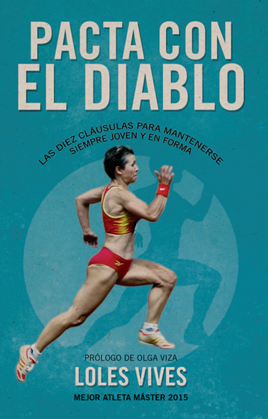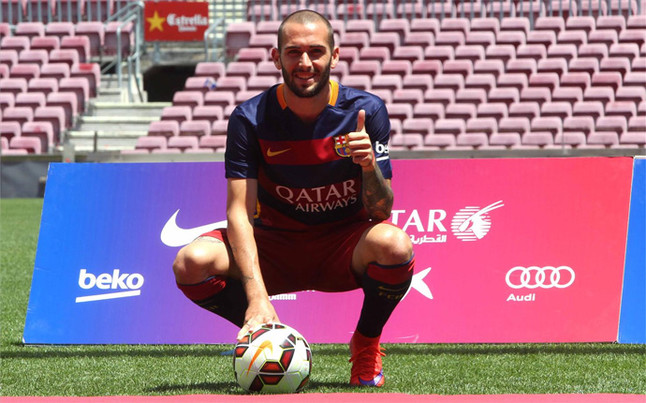Aleix Vidal has more challenges to overcome at Barça
The first two names that came to mind to the most of us when Aleix Vidal’s signing was confirmed were Dani Alves and Jordi Alba. The first for sharing, not only the club of precedence, but the right side, and there are doubts about if the signing of the Catalonian would be to complement Dani in his last moments at Barça, or if he came to replace him. Alves’ renovation has had all of the elements of a classic Brazilian soap opera: rudeness, hurt prides, exaggerated staging, goodbye tears because of an apparent break-up and, finally, a reconciliation and a happy ending. We’ll never know if Vidal’s signing had any kind of influence in Alves’ decision (could it convince him that it was the last offer from the club and they wouldn’t wait for him any longer?), but it’s clear that his renovation will have a great influence in Aleix Vidal’s role at Barça: both will be competing for a spot.
Regarding Jordi Alba, he doesn’t share the left wing with the player from L’Hospitalet, although Aleix can also play on the left side, but they hold many similarities in their personal history: staying in the lower categories of the club (they even shared the locker room in Infantil B), departing the club and growing up in other teams, converting from winger to full back under the management of Unai Emery, and returning to the home they didn’t want to leave in the first place.
And finally, Vidal shares with Alba and Alves an extraordinary body that allows him to perform in defense and be lavish when attacking, becoming one of the few (and so wanted) players able to occupy a whole wing by himself. Due to the little confidence that Luis Enrique shown in Montoya during the season, which led to his departure (and let’s not talk about Douglas), Aleix Vidal signifies a good addition for the squad because it fixes the team’s dependence in Alves’ health and fitness, who may not only be a safe substitute, but also a serious competitor for the starting spot.
Profile
Full name: Aleix Vidal Parreu
Shirt name: ALEIX VIDAL
Birth date: August 21st, 1989
Nationality: Spanish
Height: 1.76 m
Weight: 70 kg
Physical Aspects
Aleix Vidal’s morphology is similar to that of a middle distance runner than the one of a sprinter, but besides holding the former’s physical display, running down the win in an inexhaustible way for entire matches, his amazing stride brings him close to the latter allowing him to surpass most of the rivals with his speed. Also, due to his agility, he’s able to perform violent and effective jogs, which give him better chances for overlapping when he runs out of field and it’s not possible to win with a long race.
Unlike Alba, Aleix Vidal has a more explosive acceleration and he’s harder to knock down, what makes him more similar to Alves in that regard. Without being a specialist, Aleix aerial game due to his height is arguably better than the other Barça full backs, especially Alba, cursed by his low stature.
Psychological Aspects
The road that Aleix Vidal had to take to get to the football elite has been everything but easy. He went through the academies of Barça, Real Madrid, Espanyol and Nàstic of Tarragona, with loans to different youth teams and exotic destinations such as the Greek team Panthrakikos. Nearing his 21st birthday, he was ending a season with Mallorca B without having the opportunity to play with the first team, so he accepted Almeria’s offer as a last chance to get to the top. And finally his luck changed: in August 2011 he’d made it to the first team and answered with effort and sacrifice the confidence Lucas Alcaraz had given him. With Almeria, he achieved the promotion to First Division, and after two seasons in the top category, Monchi signed him, at Sevilla Unai Emery would turn him into one of team stalwarts, where he completed a spectacular season, crowned by the Europa League crown.
This history of sacrifice and personal superation explains perfectly Aleix Vidal’s character. He’s an inexhaustible fighter with an infinite hunger for success, a competitive animal that never gives up, and that’s exactly what a locker room like Barça’s needs, which comes from achieving again what seemed to be impossible to repeat, the sextuple. Aleix Vidal is a shot of ambition and dedication in the daily ongoings of a dressing room of the conquerors of the treble and that won’t give Dani Alves a chance to relax as his main competitor for a starting position.
Besides that, his character lead him to have a learning and adaptability that made it easy for Emery to take the risk and use Aleix as right back. A position for which he’s been signed even if he doesn’t recognizes it as his own, but like he said in his presentation: “I’m not a full back, but I’ll have time to work in the specific demands of the position. I’ve come to earn myself a place in the XI.”
Technical Aspects
Unlike Jordi Alba, who ended up as left back, in part, for his technical limitations when he faced tight defenses, Aleix Vidal’s conversion to a full back comes as an answer for other questions.
The new blaugrana player is almost as fast with the ball as without it. He has a splendid ball control that’s often a synonym of danger when he finds spaces, along with a good amount of ability to dribble in small spaces. The technique and agility to change directions. In this aspect, he surely surpasses both Alba and Alves.
He doesn’t shine for being a great crosser, but in spite of that he’s a good at assisting and possesses decent finishing, which allowed him to end the 2015/15 season with 6 goals and 11 assists, numbers that are also explained by playing as a winger most of the season, his conversion to the right back position was a bet by Emery for the last third of the campaign.
Tactical Aspects
Aleix Vidal is a complete wildcard, what gives him greater value when it comes to choosing any tactical formations. He can play on both sides, but he prefers the right one, performing as a winger (his natural position), a full-wing player, an attacking midfielder or a full back. In Barcelona, it seems that his fate is to be the right back, but given his characteristics, his functions on the team will need changes in his playing style, or the introduction of new tactical variants on Barcelona’s right side, one that worked incredibly well in the last part of the treble winning season.
Offensive
Space is Aleix Vidal’s natural habitat, because with space is when he can benefit from his speed. Starting from the back instead of the wings adds a surprise factor to his game that makes him even more dangerous, reason why Unai Emery decided to use him in that position. In offensive transition he can occupy space, doubling his value and without abusing individual plays, because he prefers to associate with his teammates and getting the ball back with long passes. But he also trusts in his technical qualities to lead counterattacks if necessary.
This could make his conversion easier as Jordi Alba’s counterpart for the right side but with more goals, what drives differentiates him from being a replica of Dani Alves. Because, even if the Brazilian has performed in a role similar to the one we just described during most of his career, and in fact he played as a false winger during the first part of the season, in the end Alves has shined playing as a false inner midfielder, playing behind the ball and close to Busquets, where he has provided short passing game and combinations with Messi than overlapping by the right side.
It’s fact that assuring the best tactics for the Argentinian star is an obligation if Barça are repeat its recent successes, the question remains if Luis Enrique will ask Aleix Vidal to work more in his combinative game to try and replicate this role of Alves, or on the contrary, he’ll give him green light to run on the right side, making Rakitic and Rafinha the candidates to become Messi’s main partner when Alves is not on pitch.
Defensive
We must take in consideration that Aleix Vidal just played a handful of matches as a right back, so it’s natural that he’s got a lot more to achieve in terms of consistency, positioning and defending. Like Vidal himself acknowledged during his presentation, one of his main objectives during the months he will not be playing because of the FIFA ban will be used to master defensive concepts. At the time, what we’ve seen of him in Sevilla is that he has tried to compensate for his mistakes in defense, caused by his inexperience in the position, by compensating with his physical skills.
Luis Enrique demands of him to participate in attack will also affect his performance in defense and one of the players that share the right wing with him, and with Messi being one of them, the list is basically reduced to the inner right midfielder. If Aleix is asked to act as a long full back, running the entire wing as Alves did in the first half of the season, Rakitic would have to bear, once again, the brunt of the system to cover the back of the defender from becoming a toll-free road for the rivals. If Aleix is to replicate the game of the Brazilian that we’ve seen since March, being Messi’s partner in attack but also the main ally of Busquets in post ball loss pressure, then he’ll need to learn from the one from Badía to decipher where the ball is likely to be every time, when to pressure and when not to.
In brief, Aleix Vidal has a major challenge ahead of him: after completing a whole obstacle course during his career to win a spot in the most trophy laden dressing room of the last decade, he must reinvent himself as a full back (and maybe even as a false inner midfielder) to become an important part of the team. He has as much he has to learn and assimilate as capability to succeed, learn and adapt, that he has been demonstrating constantly after facing and overcoming the difficulties that his destiny brought him.
* Xavier Codina.
Translator: Mark Coyle @mcoyle30


BUSCADOR DE CATEGORÍAS
BUSCADOR POR MES
ÚLTIMOS TWEETS
Tweets por @martiperarnauSÍGUENOS EN FACEBOOK







